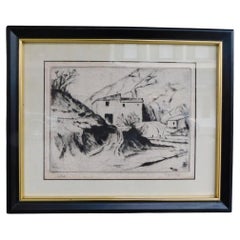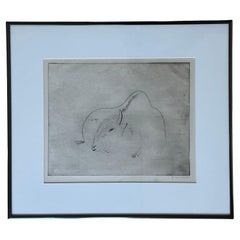Alfred Hutty Furniture
to
1
1
1
1
1
1
1
1
1
1
1
1
1
7,546
3,967
2,548
2,244
Creator: Alfred Hutty
American Dry Point Engraved Etching Italian House on Hill Side, A. Hutty C 1920
By Alfred Hutty
Located in Charleston, SC
American dry point engraved landscape etching Italian House on Hill Side, Alfred H. Hutty, Early 20th century
Category
1920s American Modern Vintage Alfred Hutty Furniture
Materials
Paper
Related Items
Vintage Dry Point Etching "Bison" by Józef Hecht
By Józef Hecht
Located in San Diego, CA
Vintage dry point etching "Bison" by noted artist Józef Hecht, circa 1930s. The piece is hand signed and titled in pencil by the artist and numbered 18 of 40 in the lower left. The i...
Category
Early 20th Century French Alfred Hutty Furniture
Materials
Paper
" Gendarme On Horseback " After Lalaisse Hand-Painted Watercolor 20th Century
Located in Beuzevillette, FR
Anonymous watercolor and drawing "Gendarme on horseback" after the work of the painter Lalaisse which is part of the collection of watercolor...
Category
Early 20th Century French Alfred Hutty Furniture
Materials
Paper
H 11.82 in W 5.52 in D 0.79 in
1960s Set of 3 Italian Architectural Etchings
Located in Chula Vista, CA
1960s Set of 3 Italian Architectural Etchings
Signed hard to read
20.5 x 15.75 x .75 Art 16 x 12
Preowned vintage unrestored condition.
M...
Category
1960s Italian Mid-Century Modern Vintage Alfred Hutty Furniture
Materials
Paper, Glass
Flemish School, Circle of Paulus Potter Bull Drypoint and Red Chalk 17th Century
Located in Beuzevillette, FR
Beautiful Flemish drawing from the 17th century made with drypoint and red chalk representing a bull in profile. This naturalistic drawing takes up the favorite theme of the painter Paulus Potter...
Category
17th Century Dutch Antique Alfred Hutty Furniture
Materials
Paper
H 13 in W 14.97 in D 0.79 in
French painting « the Masquerade » , 19th Century - Louis XV style
Located in Beuzevillette, FR
Beautiful painting representing a woman of the XVIIIth century. The scene is set in a typical interior of the period, recognisable by the furniture, armchair and bench in the Louis X...
Category
19th Century French Antique Alfred Hutty Furniture
Materials
Paper
Drawing, 18th Century French School, the Sedan Chair
Located in Kittery Point, ME
Two men with a cab or the Sedan chair, in the style of Touzé.
Bears collector's stamp (possibly the eye-form mark of Nathaniel Hone) and inscribed indi...
Category
Late 18th Century French Neoclassical Antique Alfred Hutty Furniture
4 Etchings by WG Beal, Marblehead, Rock Port, Folly Point & Annisquam, 1880's MA
Located in Bedford Hills, NY
Set of four etchings by American artist William Goodrich Beal, circa 1880s. Scenic Massachusetts coastal towns and beaches. All signed in ...
Category
1880s American American Classical Antique Alfred Hutty Furniture
Materials
Paper
H 12 in W 16 in D 0.01 in
Set of Four Drawings of Study of Archaeological Piece Greek Vases 18th Century
Located in Beuzevillette, FR
Set of four studies of archaeological excavations of the 18/19th in Nola and Sicily. Nola is known to be a city at 20 km from Pompeii, very famous for its archaeological wealth.
The ...
Category
Late 18th Century Italian Classical Greek Antique Alfred Hutty Furniture
Materials
Paper
H 15.24 in W 21.19 in D 0.6 in
Brown Pelican Lithograph, Signed
By Richard Sloan
Located in Dallas, TX
Richard Sloan "Brown Pelican" lithograph, hand-signed, copyright 1972 (American, 1935-2007)
Category
20th Century Alfred Hutty Furniture
17th Century, Pair of Italian Ink Drawings on Paper with Studies for Grotesques
Located in IT
17th century, pair of ink drawings on paper with studies for grotesques, friezes and helmets.
Painter of central Italy of the 17th century, signed with monogram “A.M.”.
Measurements: cm L 45.5 x H 59.5 x 5.5; cm 22 x 33 / cm L 46.5 x H 59 x 5.5; cm 22.5 x 31.5
The pair of sheets, in good condition, is framed by antique frames in carved and gilded wood. They show some china studies with some studies for different subjects. Specifically, the first sheet represents the design of a frieze of Renaissance taste under which are some studies probably referring to a family coat of arms. Below the center is a monogram “A.M.”.
The sheet is also worked on the back in which are drawn some articulated elements of decoration in the style of the Renaissance grotesque...
Category
17th Century Italian Baroque Antique Alfred Hutty Furniture
Materials
Paper
H 23.63 in W 18.51 in D 2.37 in
James Jacques Joseph Tissot "Soirée d'été" 'Summer Evening' Etching & Dry Point
By James Tissot
Located in Los Angeles, CA
A fine French 19th century etching and drypoint Titled "Soirée d'été" (Summer Evening) by Jacques Joseph Tissot (French, 1836-1902) depicting Mrs. Kathleen Newton resting on a lounge chair. Signed and dated (l/l): J.J. Tissot, 1881 in the plate. Under the mat, the front of the sheet inscribed in pencil with a '1' in a circle, the verso of the sheet with old price inscription "450-" in pencil. Circa: 1881-1882.
Measures: Plate Height: 9 inches (22.9 cm)
Plate Width: 15 1/2 inches (39.4 cm)
Sheet Height: 14 1/2 inches (36.8 cm)
Sheet Width: 20 5/8 inches (52.4 cm)
Frame Height: 19 inches (48.3 cm)
Frame Width: 24 1/2 inches (62.2 cm)
Frame Depth: 1 1/8 inches (2.9 cm)
Literature:
Wentworth 56. Note: Tissot's from 1881 is said to depict his lover, the Irish divorcee Mrs. Kathleen Newton, resting on a lounge chair.
Provenance:
Private collection, Los Angeles, California
Jacques Joseph Tissot (French, 15 October 1836 – 8 August 1902), Anglicized as James Tissot, was a French painter and illustrator. He was a successful painter of Paris society before moving to London in 1871. He became famous as a genre painter of fashionably dressed women shown in various scenes of everyday life. He also painted scenes and characters from the Bible.
Jacques Tissot was born in the city of Nantes in France and spent his early childhood there. His father, Marcel Théodore Tissot, was a successful drapery merchant. His mother, Marie Durand, assisted her husband in the family business and designed hats. A devout Catholic, Tissot's mother instilled pious devotion in the future artist from a very young age. Tissot's youth spent in Nantes likely contributed to his frequent depiction of shipping vessels and boats in his later works. The involvement of his parents in the fashion industry is believed to have been an influence on his painting style, as he depicted women's clothing in fine detail. By the time Tissot was 17, he knew he wanted to pursue painting as a career. His father opposed this, preferring his son to follow a business profession, but the young Tissot gained his mother's support for his chosen vocation. Around this time, he began using the given name of James. By 1854 he was commonly known as James Tissot; he may have adopted it because of his increasing interest in everything English.
In 1856 or 1857, Tissot travelled to Paris to pursue an education in art. While staying with a friend of his mother, painter Elie Delaunay, Tissot enrolled at the Ecole des Beaux-Arts to study in the studios of Hippolyte Flandrin and Louis Lamothe. Both were successful Lyonnaise painters who moved to Paris to study under Jean-Auguste-Dominique Ingres. Lamothe provided the majority of Tissot's studio education, and the young artist studied on his own by copying works at the Louvre, as did most other artists of the time in their early years. Around this time, Tissot also made the acquaintance of the American James McNeill Whistler, and French painters Edgar Degas (who had also been a student of Lamothe and a friend of Delaunay), and Édouard Manet.
In 1859, Tissot exhibited in the Paris Salon for the first time. He showed five paintings of scenes from the Middle Ages, many depicting scenes from Goethe's Faust. These works show the influence in his work of the Belgian painter Henri Leys (Jan August Hendrik Leys), whom Tissot had met in Antwerp earlier that same year. Other influences include the works of the German painters Peter Von Cornelius and Moritz Retzsch. After Tissot had first exhibited at the Salon and before he had been awarded a medal, the French government paid 5,000 francs for his depiction of The Meeting of Faust and Marguerite in 1860, with the painting being exhibited at the Salon the following year, together with a portrait and other paintings.
Émile Péreire supplied Tissot's painting Walk in the Snow for the 1862 international exhibition in London; the next year three paintings by Tissot were displayed at the London gallery of Ernest Gambart.
In about 1863, Tissot suddenly shifted his focus from the medieval style to the depiction of modern life through portraits. During this period, Tissot gained high critical acclaim, and quickly became a success as an artist. Like contemporaries such as Alfred Stevens and Claude Monet, Tissot also explored Japonisme, including Japanese objects and costumes in his pictures and expressing style influence. Degas painted a portrait of Tissot from these years (Metropolitan Museum of Art, New York), in which he is sitting below a Japanese screen hanging on the wall.
Still on Top, 1873
Tissot fought in the Franco-Prussian War as part of the improvised defense of Paris, joining two companies of the Garde Nationale and later as part of the Paris Commune. His 1870 painting La Partie Carrée (The Foursome) evoked the period of the French revolution. Either because of the radical political associations related to the Paris Commune (which he was believed to have joined mostly to protect his own belongings rather than for shared ideology), or because of better opportunities, he left Paris for London in 1871. During this period, Seymour Haden helped him to learn etching techniques. Having already worked as a caricaturist for Thomas Gibson Bowles, the owner of the magazine Vanity Fair, as well as exhibited at the Royal Academy, Tissot arrived with established social and artistic connections in London. Tissot used...
Category
Late 19th Century French Victorian Antique Alfred Hutty Furniture
Materials
Glass, Wood, Paper
H 19 in W 24.5 in D 1.13 in
École Française « Cherry Botanic Drawing », Early 20th Century
Located in Beuzevillette, FR
Nice drypoint botanical drawing of a cherry tree branch. The representation is naturalist and shows all the elements forming the cherry tree : the fl...
Category
20th Century French Alfred Hutty Furniture
Materials
Paper
Previously Available Items
Alfred Hutty Original Etching, circa 1935, “The Sword Gate”
By Alfred Hutty
Located in Phoenix, AZ
Original etching of a scene from Charleston, South Carolina by New York/Charleston artist Alfred Heber Hutty (1877-1954).
Signed in pencil lower right “Alfred Hutty...
Category
Mid-20th Century Alfred Hutty Furniture
Materials
Paper
Alfred Hutty furniture for sale on 1stDibs.
Alfred Hutty furniture are available for sale on 1stDibs. These distinctive items are frequently made of paper and are designed with extraordinary care. There are many options to choose from in our collection of Alfred Hutty furniture, although gray editions of this piece are particularly popular. Many of the original furniture by Alfred Hutty were created in the modern style in united states during the early 20th century. Prices for Alfred Hutty furniture can differ depending upon size, time period and other attributes — on 1stDibs, these items begin at $1,229 and can go as high as $2,800, while a piece like these, on average, fetch $2,015.



